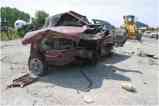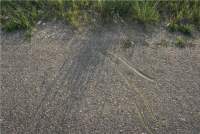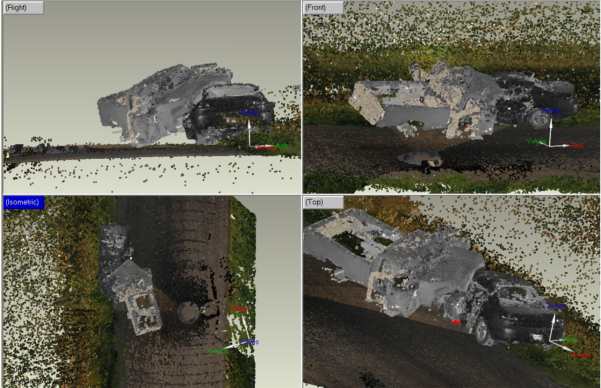Ford Ranger-Dodge Avenger Collision
![]()
 On June 16, 2005 in Republic County, KS a northbound 1985 Ford Ranger collided head-on with a southbound 1998 Dodge Avenger on a paved county road. There were no eyewitnesses beyond the involved parties and both sides claimed that the other party had crossed into their side of the roadway. JRLA and James Loumiet were hired to reconstruct the collision to try to determine the impact positions, directions, and speeds of the vehicles.
On June 16, 2005 in Republic County, KS a northbound 1985 Ford Ranger collided head-on with a southbound 1998 Dodge Avenger on a paved county road. There were no eyewitnesses beyond the involved parties and both sides claimed that the other party had crossed into their side of the roadway. JRLA and James Loumiet were hired to reconstruct the collision to try to determine the impact positions, directions, and speeds of the vehicles.
Both vehicles had significant crush damage as a result of the collision and the pavement had gouges that were caused by the collision. Mr. Loumiet inspected, measured, photographed, and laser scanned the site and the vehicles. The scanned vehicles were then brought to the virtual collision site using Geomagic Studio point cloud modeling software to match the damage to the two vehicles and the roadway gouges caused by the collision.
 The crush damage from the two vehicles and the gouges on the roadway were matched in the virtual environment so that the vehicles were placed in their impact positions on the roadway. The impact headings and speeds of the two vehicles were then calculated using conservation of momentum and energy methods.
The crush damage from the two vehicles and the gouges on the roadway were matched in the virtual environment so that the vehicles were placed in their impact positions on the roadway. The impact headings and speeds of the two vehicles were then calculated using conservation of momentum and energy methods.
 The heading information was used to finalize the positioning of the vehicles in the virtual environment. The analysis showed that the Ranger was heading northbound on 260 Road when it crossed into the southbound side of the roadway resulting in the collision.
The heading information was used to finalize the positioning of the vehicles in the virtual environment. The analysis showed that the Ranger was heading northbound on 260 Road when it crossed into the southbound side of the roadway resulting in the collision.
The Ranger was traveling between 55-56 mph at impact. Immediately after impact the Ranger had a speed between 17-20 mph and rolled onto its roof and spun approximately 180 degrees, coming to rest approximately 34 feet north of its impact position, on its roof and facing south.
The Avenger was heading southbound immediately prior to impact. The straddling of the west road edge by the Avenger at impact indicates that the driver was probably taking evasive steering maneuvers to the west shortly before impact in an attempt to avoid the collision. The Avenger was traveling at approximately 45 mph at impact. Immediately after impact the Avenger had a speed of 19-21 mph and spun counterclockwise approximately 200 degrees and slid approximately 29 feet to the southwest to its final rest position.
![]()
